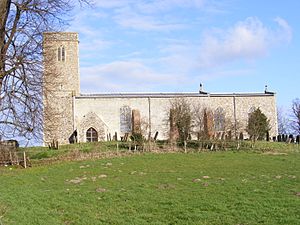All Saints Church, Ellough facts for kids
Quick facts for kids All Saints Church, Ellough |
|
|---|---|

All Saints Church, Ellough, from the south
|
|
| Lua error in Module:Location_map at line 420: attempt to index field 'wikibase' (a nil value). | |
| OS grid reference | TM 443 866 |
| Location | Ellough, Suffolk |
| Country | England |
| Denomination | Anglican |
| Website | Churches Conservation Trust |
| Architecture | |
| Functional status | Redundant |
| Heritage designation | Grade I |
| Designated | 1 September 1953 |
| Architectural type | Church |
| Style | Gothic |
| Groundbreaking | 14th century |
| Closed | 1970s |
| Specifications | |
| Materials | Flint with stone dressings |
All Saints Church is an old Anglican church located in Ellough, Suffolk, England. It's a "redundant" church, which means it's no longer used for regular services but is kept safe and preserved. This church is very old, dating back to the Middle Ages. It's so important that it's officially recognized as a Grade I Listed building, meaning it's a building of special historical interest. The Churches Conservation Trust looks after it. You can find the church standing by itself on a small hill, about 4 kilometers (2.5 miles) south-east of Beccles.
Contents
History of All Saints Church
Early Beginnings and Changes
This church was first built in the 14th century. That's over 700 years ago! In 1602, a south porch was added. A man named Thomas Love paid for this new part.
In 1643, some changes happened inside the church. William Dowling, who was a very strict Puritan, visited. He had the wall paintings removed from the church.
Later Years and Restoration
In the 18th century, land from a nearby church, St Marys in Willingham St Mary, was joined with Ellough. You can still see where St Marys church used to be from All Saints.
The church was given a big update in 1882. This was part of a common trend called "Victorian restoration." An architect named William Butterfield led this work. During this time, the east window was replaced.
A Long-Serving Rector
Richard Aldous Arnold became the rector (the main priest) of Ellough in 1830. He stayed in this job for more than 60 years! That's a very long time.
His sons, William Munnings Arnold and Frederick Arnold, were both born in Ellough. William became a politician in Australia. Frederick was a famous rower. You can find memorials for Richard Arnold and his wife on the south wall of the chancel inside the church. Richard Arnold is also known for building the parsonage, which is the house for the rector, next to the church around 1830. This house is also a Grade II listed building.
Closing for Regular Services
In the 1970s, the church's parish was combined with Weston. All Saints Church was mostly closed after that. Only special services happen there sometimes now.
Architecture of the Church Building
Materials and Layout
All Saints Church is built from flint rubble (rough stones) with special stone details. The main part of the church, called the nave, has a smooth, rendered (stucco) finish. The roofs are covered with felt.
The church has a simple layout. It includes a two-bay nave (the main area where people sit). It also has a two-bay chancel (the area near the altar). There is a south porch at the entrance. A north organ chamber is where the organ would be. Finally, there is a west tower.
Tower and Windows
The tower was built in the 14th century. It doesn't have buttresses (supports) on the outside. The tower has two-light bell openings. These are windows with two sections, featuring Y-shaped stone patterns called tracery. The top of the tower has a flat parapet (a low wall).
The nave has windows from the 15th century, also with two lights. The doorway on the north side of the nave is now blocked up. The south nave doorway and the porch were added in the 19th century. The chancel has two-light windows on its sides. The large east window, which has three lights, was replaced in the 19th century.
Inside the Church
Inside All Saints Church, you can find some interesting old features. There's a 14th-century piscina. This is a stone basin used for washing sacred vessels. There is also a sedilia, which are stone seats for the clergy.
You can still see the stairs that used to lead to the rood loft. This was a wooden gallery above the entrance to the chancel. The font, where baptisms take place, is octagonal (eight-sided). It dates from the 15th century. Its bowl is carved with shields and flowers.
The reredos (a screen behind the altar) and the chancel ceiling were designed by William Butterfield. There are also memorials inside. These include two brasses (engraved metal plates) in the sanctuary (the area around the altar). There is also a large stone slab from the mid-18th century in the chancel. Many of the church's original fittings have been removed over time.
See also

